A Treasure Trove of Research: The Tambopata Macaw Project
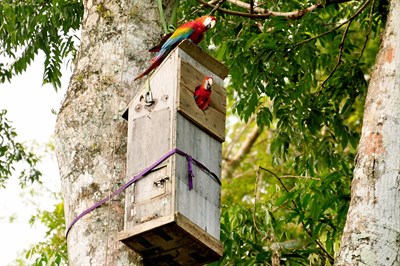
Deep in the Peruvian rainforest, 20 kilometers from the nearest road, stands the headquarters of the Tambopata Macaw Project, a combination ecotourism lodge and scientific research station. Waking up well before sunrise, teams of dedicated parrot researchers make daily trips into the jungle, braving intense humidity, thick forests, and unpredictable rivers to observe macaws in their native habitat. They climb up 150-foot trees; spend hours counting birds at clay licks; and carefully gather, measure, and return chicks to nests—while keeping a close eye on the birds’ movements through the rainforest canopy.
These adventures are all in a day’s work at the Tambopata Macaw Project, where an ever-changing crew of scientists, graduate students, foreign volunteers, and Peruvian employees work under the leadership of Dr. Donald Brightsmith, assistant professor in the Department of Veterinary Pathobiology at the Texas A&M College of Veterinary Medicine & Biomedical Sciences (CVM).
Since Brightsmith took over as director in 1999, the group has collected years of data on macaws. “I’ve had researchers recording data every single day since November 2000,” he said. It’s a treasure trove of research that Brightsmith hopes will fill in the knowledge gaps about macaw conservation and ecology.
From Long Island to the Amazon
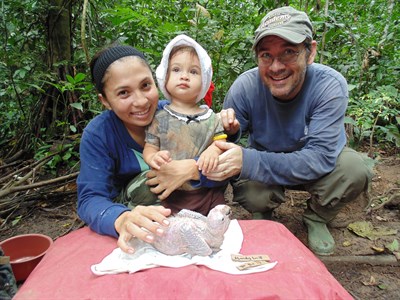
Brightsmith grew up on Long Island, New York, just outside New York City. Despite his urban roots, he has been a lifelong naturalist and bird watcher, “much to the joy of my classmates, who would pick on me for it all the way through graduate school,” he observed humorously. That early love of birds propelled him through academia, from his bachelor’s degree in natural resources at Cornell University, to his master’s degree in wildlife ecology at the University of Arizona, to his doctorate in zoology at Duke University.
During these years, Brightsmith’s passion for birds focused on a growing interest in parrots. A trip to Costa Rica in graduate school sparked his fascination with tropical birds, and his first wife introduced him “to the world of crazy parrot owners,” he said. But Brightsmith credits a single book—Beissinger and Snyder’s New World Parrots in Crisis (1992)—for opening his eyes to the plight of tropical parrots. “It pointed out that we don’t know much about parrots in the wild,” he said. “They’re having serious problems. They’re highly valuable both as a tourism resource and a captive resource. Yet, especially in the early ’90s, we knew almost nothing about where parrots breed, what they eat, or what habitats they use in the wild. It was an incredible disconnect.”
Around the time he was finishing up his doctoral research in zoology at Duke, Brightsmith was introduced to the Tambopata Macaw Project. Established in 1989, the project had briefly earned international recognition for its work on parrot clay licks and macaw nesting, but since the early 1990s had been languishing. Brightsmith said he saw a golden opportunity to revitalize the project and “make a difference by looking at this group of birds that are hard to work with.” In 1998, he flew to Peru and met with the project leaders. “I convinced them that if they gave me a small amount of money, I wouldn’t be a full-time employee, but I would start to run this research as a scientific endeavor again,” Brightsmith said. His pitch was successful, and the Tambopata Macaw Project was reborn under his enthusiastic leadership.
A marriage of ecotourism and research
The project began in 1989 when Peruvian researchers and entrepreneurs, Eduardo Nycander and Kurt Holle, founded both Rainforest Expeditions, a for-profit ecotourism company, and the Tambopata Macaw Project. From the beginning, Rainforest Expeditions owned and operated the remote lodge that served as both a research base and a tourist destination. “From the beginning, it was always a mixture of tourism and research,” Brightsmith explained. “They wanted the two to feed off of each other.”
So far, the venture has been uniquely successful and financially sustainable. Rainforest Expeditions provides lodging, food, and utilities, charging the macaw researchers a reduced fee. Foreign volunteers pay higher daily fees, and the difference goes toward paying wages and lodging for Peruvian workers. In exchange, every group of tourists at the ecolodge receives a scientific presentation from the researchers about current research and threats to macaws.
The marriage of ecotourism and conservation research is not only a boost to the Peruvian economy, but also one of the main reasons the Tambopata Macaw Project has been able to carry on so successfully for decades. Brightsmith estimated that Rainforest Expeditions provides over $30,000 in project funding every year. “It’s not a completely sustainable system right now, but all it requires is a few thousand dollars of extra financing, which is much cheaper than a full research lab,” Brightsmith said. “This is one of the reasons why the project is still going after 20 years.”
The Schubot connection
Of course, the data they collect still requires a laboratory and experts to analyze it. That’s where Texas A&M’s Schubot Exotic Bird Health Center comes into play. Brightsmith was recruited to Texas A&M by Schubot Center Director and Distinguished Professor Dr. Ian Tizard in 2005. After some initial research collaborations with Brightsmith, Tizard visited the Tambopata Center and offered Brightsmith a job as a lecturer at the CVM.
For Brightsmith, the Schubot Center was an irresistible draw, and the relationship has paid off. “The Schubot Center provides the platform for my work,” he said. “Over the years, they have provided financial assistance and a community of scholars. Because the center exists and it’s endowed, it will always attract a group of people interested in bird research, even those who don’t know that they’re interested in bird research.”
Brightsmith credits Tizard with making the Schubot Center a vibrant hub for avian research, always bringing new scientists from different disciplines into the fold. “If he needs a microbiologist, he finds a microbiologist who knows what a bird is,” Brightsmith said. “Right now we’re working with a geneticist who works on conifer trees, but all of these people are now working on bird-related issues because the Schubot Exotic Bird Health Center exists. I am within that milieu, and it provides a community of people interested in exotic bird issues.”
Current research
Groundbreaking studies about macaws using clay licks to gather essential minerals put Tambopata on the map in the 1990s, and that research continues today. Brightsmith’s team has also published papers explaining their success using artificial nest boxes to increase breeding success. However, over time, the Tambopata project’s main focuses have shifted to new questions.
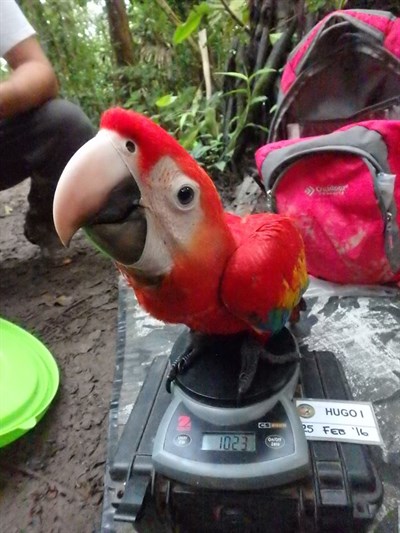
Right now, Brightsmith’s main interest is the macaws’ movements and how they change in relation to seasonal events. Researchers use lightweight collars to track the movements of individual birds. Brightsmith said he is concerned about the macaws’ most recent breeding season, which was off to a late and slow start. He speculates that the El Niño weather patterns and the resulting low food supply might have something to do with it. To sort out the irregularities and what they might mean for the future of the species, he hopes to compare data from the past several years.
“At this point, we’ll be able to reflect back and see what happens when you have this odd change in plant resources and how that impacts [macaw movements and breeding],” explained Brightsmith. “Understanding what happens in an El Niño year may give us a better view into the future of what happens as larger-scale climate change alters the plants and their fruiting and flowering.”
Similarly, a shift in movement from one clay lick to another has piqued Brightsmith’s curiosity about the future. “We don’t understand how climate change and clay lick use are rippling through the environment and changing things. We need to look more carefully at these climate-related issues—the annual variations and how they correlate with the environment—which will give us a better ability to predict global change ideas.”
Brightsmith’s wife, Gabriela Vigo Trauco, Peruvian ecologist, Tambopata project coordinator, and current Ph.D. student in Wildlife and Fisheries Sciences at Texas A&M, is “studying scarlet macaw breeding systems using a combination of ecology, animal behavior, and genetic analysis.” The Tambopata location is perfect for her research because that species is not yet endangered in the Peruvian Amazon. “There we can study things that you cannot study in areas in which the species is endangered,” Vigo Trauco explained. “So, that’s the way I want to lead my research.”
CVM students are also using Tambopata as a site for fieldwork and graduate research. Every year, Brightsmith and Dr. Sharman Hoppes, clinical associate professor at the CVM, take two to four veterinary students on a study abroad experience at the station. Students from around Texas A&M’s campus spend time in Tambopata as both volunteers and doctoral researchers.
Hope for the future
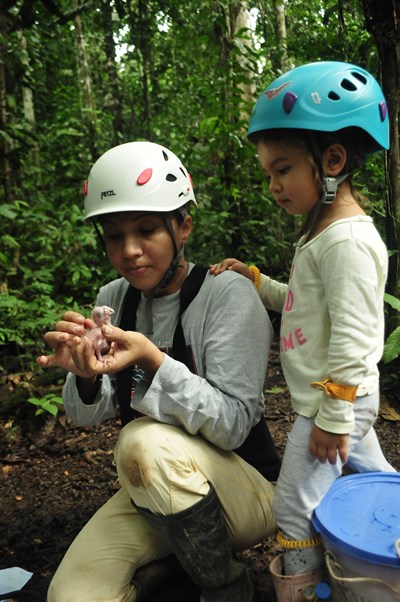
These days, Brightsmith and Vigo Trauco make it to Tambopata only twice a year. It’s not as much as they’d like, but their life in College Station keeps them busy. Brightsmith is a full-time assistant professor and admits that he spends most of his time behind a computer, analyzing and writing up data collected from years of research. “Right now, if you told me I could never take another data point on a macaw, I probably could finish out my career publishing on the amount of information we have,” he joked. “We’re currently publishing some of the important relationships between breeding and clay lick use and food and movement. It’s building a jigsaw puzzle where the first thing you have to do is build each piece. We’re building the pieces and fitting them together as we go.”
Vigo Trauco is immersed in reviewing video data from macaw nests. “We have collected over 30,000 hours of video in the past six years,” she said. Additionally, she is restarting her genetic research; a 10-year ban on exporting genetic materials out of Peru was lifted this year, allowing her to move forward with her projects.
Most of all, the couple is devoted to raising their daughter, four-year-old Amanda Lucille, or “Mandy Lu.” For the Brightsmith family, the Tambopata Macaw Project is now a family affair. Brightsmith and Vigo Trauco met on the project, and now they bring their daughter to share in their love of the rainforest and its vibrant inhabitants. Mandy Lu—”our little rainforest monster,” as Brightsmith affectionately calls her—seems to share her parents’ enthusiasm for the Amazon. “Maybe it’s because we like it, and she sees that we’re super happy in the rainforest,” Vigo Trauco speculated. “Maybe she is connecting happiness with being in the jungle.”
Either way, sharing her beloved rainforest with Mandy Lu has shifted Vigo Trauco’s long-term goals for the Tambopata Macaw Project. She envisions the Tambopata project as an opportunity to get Peruvian students interested and involved in conserving their country’s unique natural resources. “I think it would be nice to involve young people—young adults, in high school or their first years of college—and try to put that seed in their brains that conservation can actually help and actually can happen and be fun,” she said.
Brightsmith is also enthusiastic about the opportunities to teach conservation values to people in Peru and around the world. “We’ve had thousands of tourists who have gone through our talks and seen the site and the birds and really gotten a feel for what the real rainforest is like,” he said. He’s also seen changes in local attitudes. “The project has played into this shift in mindset,” he explained. “While some locals use the money they make from ecotourism to buy bigger chainsaws, there is the development of a mindset that has led this community to be much more deliberate in their planning as to how they’re going to use their natural resources.” Both Brightsmith and Vigo Trauco look to the younger generation of Peruvians and conservationists—hopefully some from the CVM—to build a brighter future for macaws and the rainforest.
If you want to visit the site as a tourist or guest, check out
Rainforest Expeditions at www.perunature.com.
Dr. Sharman Hoppes: Avian Veterinarian in the Jungle
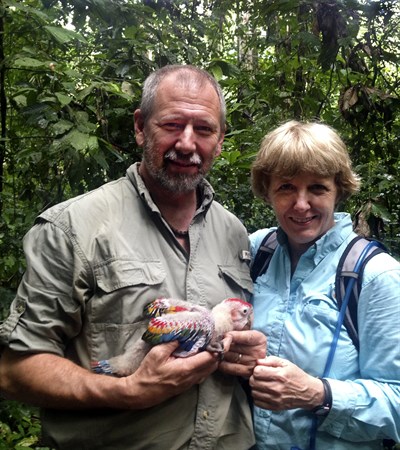
Since teaming up with Brightsmith in 2008, Sharman Hoppes, DVM, ABVP, and clinical associate professor at the CVM, has been flying south for the winter, straight to the Tambopata Macaw Project.
For two to three weeks, Hoppes trades in her exotic animal clinical duties at the Small Animal Hospital for a small, rustic Amazonian research facility with minimal electricity and no air conditioning. There, she runs the veterinary side of the operation, training students and making sure everybody’s projects stay on track.
Hoppes’ main concern is animal welfare. Working with wild birds unused to human handling adds a layer of complexity to her research. “I’m always very aware that we don’t want to over-stress a bird that we are handling, making it weak or tired and making it a greater risk from predators,” she explained.
Most of the work they do is with the chicks, taking them out of the nest for measurements and sampling. Hoppes states that “they become more used to the handling over time, but even with the chicks, you have to be prepared and monitor how long you have them out.”
When they are trapping adult birds, Hoppes trains her team to work with assembly-line efficiency. Her goal is to minimize contact with the birds, aiming for 10–11 minutes from capture to release. Her team practices their roles in advance using bundled-up towels. “The most important thing is that we’re really prepared and make sure that we have everything within hand’s reach, everything ready to go,” Hoppes said. “Everybody knows their part, and we all know that when we get to this time period, even if we’re not done, we let the bird go.”
Veterinary work in a hot, humid jungle can be challenging, but this self-professed “city girl” revels in it. “This project changed my life,” she said. “I love it there!”


